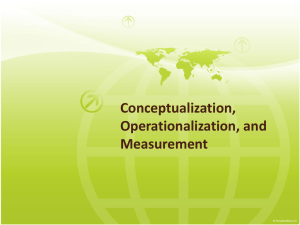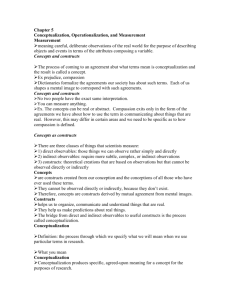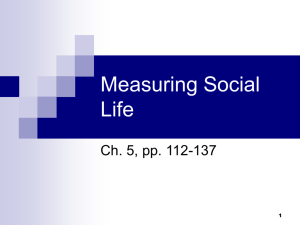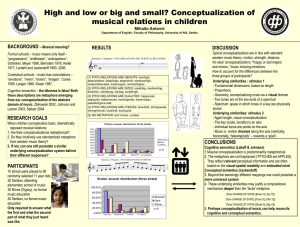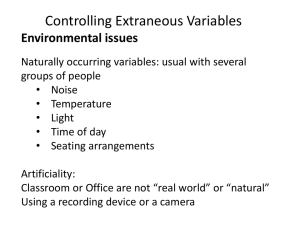chapter 5, conceptualization, operationalization, and measurement
advertisement
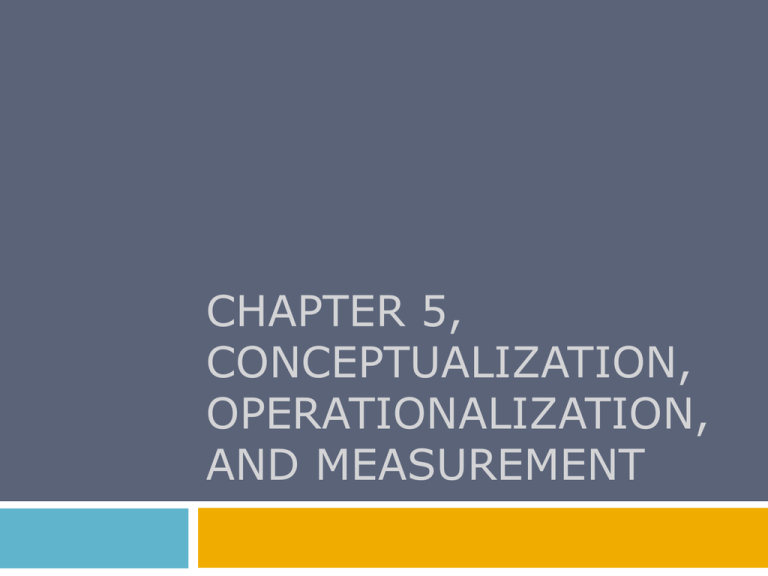
CHAPTER 5, CONCEPTUALIZATION, OPERATIONALIZATION, AND MEASUREMENT Chapter Outline Measuring Anything That Exists Conceptualization Definitions in Descriptive and Explanatory Studies Operationalization Choices Criteria of Measurement Quality The Ethics of Measurement Quick Quiz Measuring Anything that Exists Measurement – Careful, deliberate observations of the real world for the purpose of describing objects and events in terms of the attributes composing the variable. How would you measure… political party affiliation? age? grade point average? satisfaction with college? religious affiliation? Conceptions, Concepts, and Reality How would you conceptualize… prejudice? compassionate? Conceptualization – The mental process whereby fuzzy and imprecise notions (concepts) are made more specific and precise. Concepts as Constructs Concepts are constructs derived by mutual agreement from mental images. Conceptions summarize collections of seemingly related observations and experiences. Conceptualization Conceptualization – The process through which we specify what we mean when we use particular terms in research. We cannot meaningfully answer a question without a working agreement about the meaning of the outcome. Conceptualization processes a specific agreed-on meaning for a concept for the purposes of research. Indicators and Dimensions Indicator – An observation that we choose to consider as a reflection of a variable we wish to study. Dimension concept. – A specifiable aspect of a Identify appropriate indicators and dimensions for… religious affiliation college success political activity poverty binge drinking fear of crime The Interchangeability of Indicators If several different indicators all represent the same concept, all of them will behave the same way the concept would behave if it were real and could be observed. Real, Nominal, and Operational Definitions Specification – The process through which concepts are made more specific. A nominal definition is one that is simply assigned to a term without any claim that the definition represents a “real” entity. An operational definition specifies precisely how a concept will be measured – that is, the operations we will perform. Creating Conceptual Order Conceptualization Nominal Definition Operational Definition Real World Measurement Conceptualization – Practice Anomie Definitions in Descriptive and Explanatory Studies Definitions are more problematic for descriptive research than for explanatory research. Operationalization Choices Conceptualization is the refinement and specification of abstract concepts. Operationalization is the development of specific research procedures that will result in empirical observations representing those concepts in the real world. Range of Variation To what extent is the research willing to combine attributes in fairly gross categories? Variation between the Extremes To what degree is the operationalization of variables precise? Dimensions Defining Variables and Attributes An attribute is a characteristic or quality of something (ex: female, old, student). A variable is a logical set of attributes (ex: gender, age). Every variable must have two important qualities. 1. 2. The attributes composing it should be exhaustive. Attributes must be mutually exclusive. Levels of Measurement Nominal Ordinal Interval Ratio Levels of Measurement – Nominal Variables who attributes have only the characteristics of exhaustiveness and mutually exclusiveness. Examples: gender, religious affiliation, college major, hair color, birthplace, nationality Levels of Measurement – Ordinal Variables with attributes we can logically rank order. Examples: socioeconomic status, level of conflict, prejudice, conservativeness, hardness Levels of Measurement – Interval Variables for which the actual distance between attributes has meaning. Examples: score temperature, (Fehrenheit) IQ Levels of Measurement – Ratio Variables whose attributes meet the requirements of a interval measure, and has a true zero point. Examples: temperature (Kelvin), age, length of time, number of organizations, number of groups, number of As received in college Figure 5.1 Implications of Levels of Measurement Analyses require minimum levels of measurement Some variables can be treated as multiple levels of measurement Single or Multiple Indicators Criteria of Measurement Quality Precision and Accuracy Reliability Validity Precision and Accuracy Precise ones. measures are superior to imprecise Precision is not the same as accuracy. Reliability – That quality of measurement method that suggests that the same data would have been collected each time in repeated observations of the same phenomenon. Reliability is not the same as accuracy. Test-Retest Method To make the same measurement more than once. Split-Half Method Multiple sets of randomly assigned variables should produce the same classifications Established Reliability Measures of Research Workers Validity – a term describing a measure that accurately reflects the concept it is intended to measure. Face Validity – That quality of an indicator that makes it seem a reasonable measure of some variable. Criterion-Related Validity – The degree to which a measure related to some external criterion. Construct Validity – The degree to which a measure relates to other variables as expected within a system of theoretical relationships. Content Validity – The degree to which a measure coves the range of meanings included within a concept. Figure 5.2 QUICK QUIZ 1. It is truly possible to measure the stuff of life. A. True B. False Answer: A. It is truly possible to measure the stuff of life. 2. _____ refer to mental images. A. Perspectives B. Theories C. Conceptions D. Methods Answer: C. Conceptions refer to mental images. 3. The mental processes whereby fuzzy and imprecise notions are made more specific and precise is called: A. construction B. reification C. conceptualization D. operationalization Answer: C. The mental processes whereby fuzzy and imprecise notions are made more specific and precise is called conceptualization. 4. Which of the following are examples of nominal measures? A. gender B. religious affiliation C. political party affiliation D. birthplace E. all of the above Answer: E. Gender, religious affiliation, political affiliation, and birthplace are examples of nominal measures. 5. _____ is the degree to which a measure covers the range of meanings included within a concept. A. Construct validity B. Criterion-related validity C. Face validity D. Content validity Answer: D. Content validity is the degree to which a measure covers the range of meanings included within a concept. 6. In social research, the process of coming to an agreement about what terms mean is: A. hypothesizing B. conceptualization C. variable determination D. operationalization Answer: B. In social research, the process of coming to an agreement about what terms mean is conceptualization. 7. The _____ of concepts in scientific inquiry depends on nominal and operational definitions. A. specification B. interchangeability C. functioning D. network Answer: A. The specification of concepts in scientific inquiry depends on nominal and operational definitions. 8. A level of measurement describing a variable whose attributes are rank-ordered and have equal distances between adjacent attributes are _____ measures. A. ratio B. interval C. nominal D. ordinal Answer: B. A level of measurement describing a variable whose attributes are rank-ordered and have equal distances between adjacent attributes are interval measures.
